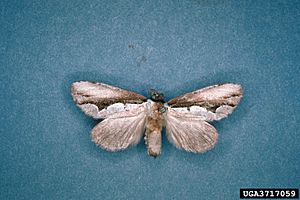Base-streaked prominent moth facts for kids
Quick facts for kids Base-streaked prominent moth |
|
|---|---|
 |
|
 |
|
| Scientific classification | |
| Kingdom: | |
| Phylum: | |
| Class: | |
| Order: | |
| Family: |
Notodontidae
|
| Genus: |
Nerice
|
| Species: |
N. bidentata
|
| Binomial name | |
| Nerice bidentata Walker, 1855
|
|
The Double-toothed Prominent Moth (Nerice bidentata) is a fascinating insect. It is also known as the base-streaked prominent moth. This moth belongs to the Notodontidae family. You can find it across a wide area of North America. Its range stretches from Nova Scotia in the east to Texas in the west. It also lives from Florida in the south up to Saskatchewan in the north.
Contents
What Does the Double-toothed Prominent Moth Look Like?
This moth is not very big. Its wingspan is usually between 30 and 40 millimeters. That's about 1.2 to 1.6 inches. The adult moths have special front wings. These wings have two different colors. The bottom part of the wing is a grayish-brown color. The top part can be light brown or even dark brown.
Unique Wing Patterns
A cool feature of these moths is a blackish band. This band separates the two colors on their front wings. It looks like it has two teeth or bumps. Sometimes, this band also has a white edge. The back wings of the moth are brown. They are a bit darker near the edges.
Life Cycle of the Moth
Adult Double-toothed Prominent Moths are active during certain times of the year. In the northern parts of their habitat, they usually fly from April to September. Sometimes, they have a second flight period from May to August. They typically have one generation of moths each year in the north.
Larvae and Their Food
The young moths are called larvae, or caterpillars. They are a chalky-green color. This helps them blend in with the leaves they eat. These larvae love to munch on the leaves of elm trees (Ulmus species). They look a lot like the edges of the elm leaves. This camouflage helps them hide from birds and other predators. You can usually find these larvae from June to October.
Images for kids



